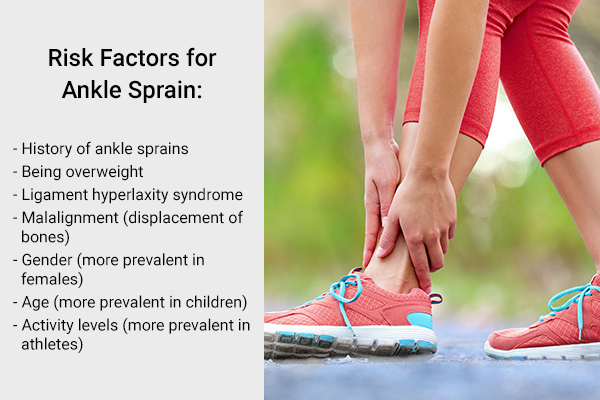In this article:
An ankle sprain is a common injury that can happen to anyone, regardless of age or activity level. People often confuse it with muscle strains.

A sprain occurs when you stretch or pull a ligament, which attaches two bones at a joint. This can happen if you fall, twist, or get hit.
A sprain is different from a strain, which happens when you injure muscles and tendons. Muscles help you move, and tendons attach muscles to bones. The seriousness of a sprain depends on the number of ligaments involved and the extent they are torn.
You can treat a sprained ankle at home with different remedies and proper care. But if your symptoms don’t improve, you may need surgery to fix the injured ligaments.
If you don’t treat a painful sprain, your ankle can become weak and more prone to future injuries. Having multiple sprains can cause problems such as regular ankle pain, instability, and arthritis. (1)(2)
In this article, learn a bit more about ankle sprains. What are the signs? How do you prevent them? And most importantly, when do you need to see a doctor?
Causes of Ankle Sprains
Patients often remember hurting their foot or ankle while twisting it, and if the ligaments are severely torn, they may hear or feel a popping sound, pointing toward an ankle sprain.
Unforeseen sprains can occur during a range of activities, including walking or exercising on an irregular surface, experiencing a fall, or engaging in sports that entail sudden movements, such as basketball, tennis, football, soccer, and trail running. (3)
Signs and Symptoms of a Sprained Ankle
The signs and symptoms of ankle sprains depend on the type and gravity of your injury. Signs and symptoms may include: (1)
- Pain
- Tenderness
- Swelling
- Instability of the ankle
- Bruising
How Serious Is My Ankle Sprain?
The following grades of severity are used to characterize sprains: (1)
Grade I
Grade I sprains are the mildest and most frequent type of sprains, characterized by stretched but not torn ligaments and a stable ankle.
Grade II
Grade II sprains are moderate sprains and are generally quite painful, because at least one of the ligaments is partially torn. The joint is therefore relatively unstable, and the movement is restricted.
Grade III
Grade III sprains are severe sprains where one or more ligaments are torn, making the ankle completely unstable. It’s scarcely probable that the foot will move at all.
Treating Ankle Sprains
Treatment for ankle sprains involves the following.
1. Nonsteroidal anti-inflammatory drugs
Orally taken or topically applied NSAIDs are generally used to reduce pain and inflammation in the initial stage of an ankle sprain. Recent studies demonstrate that the use of NSAIDs in athletes results in the ease of management of pain and swelling compared with a placebo.
Although NSAIDs are deemed to be safe, they should be prescribed judiciously due to their possible gastrointestinal, renal, and cardiovascular side effects. If not so, they may delay the natural healing process induced by the inhibition of the regular inflammatory response.
Considering the various NSAIDs for this injury, a few investigations have indicated distinguished results for diclofenac compared with ibuprofen for pain lowering in simple to serious acute sprains. (4)(5)
Gel, liquid, or patch forms of topical NSAIDs are available without a prescription, including diclofenac gel and aspirin cream, which may be useful in ankle sprains.
Note: Acetaminophen appears to be an equally useful NSAID for pain and swelling management in the first 2 weeks following an acute sprain. (6)
2. Brace use for at least 6 months
A brace should be used for a minimum of 6 months after even a slightly serious ankle sprain to discourage re-injury. Other than preventing impact, the use of braces decreases the possibility of a severe ankle sprain.
Considering the protective result of braces in athletes returning to sports following an ankle sprain, a systematic review indicated that athletes who used braces had 70% lower incidences of ankle injuries in comparison to those without any preventative support. (5)(7)
Risk Factors for Ankle Sprains

Predisposing factors that can lead to an increased risk of ankle sprains are: (8)(9)
- History of ankle sprains
- Being overweight
- Ligament hyperlaxity syndrome
- Malalignment (displacement of bones)
- Gender (more prevalent in females)
- Age (more prevalent in children)
- Activity levels (more prevalent in athletes)
What Are the Complications of Ankle Sprains?
The various complications of a sprained ankle include: (10)
- Chronic pain/disability
- Recurrent ankle instability
- Tendon injuries
- Neurovascular injury
- Arthritis
When to See a Doctor

If your symptoms are not mild or you’re not recovering well after the injury, you may need to contact your doctor.
Your healthcare expert will assess your pain and swelling to determine the severity of the injury and whether or not the affected ankle can bear weight. If not treated well, a simple sprained ankle can cause long-term problems.
If the pain and swelling persist even after trying home remedies or if you are unable to perform daily activities, it is recommended to consult a doctor.
People with uncontrolled diabetes, recurrent ankle pain, and loss of sensation should also seek medical attention. If you experience dizziness or fainting, a change in ankle shape or angle, and the inability to walk, it is advised to see an orthopedic doctor as these could be signs of a broken ankle rather than just a sprain.
Final Word
Just a simple slip or a wrong step can suddenly land you with a sprained ankle. An ankle sprain is an ordinarily seen muscle injury. It happens when at least one of the ankle ligaments gets stretched or torn. It can be a very uneasy condition, leading to pain, swelling, and complications in walking.
Most people attempt to wait out ankle injuries without seeking medical care, which may be fine. However, if an ankle sprain results in serious pain and swelling, it’s crucial to see a doctor.
Without appropriate treatment and rehabilitation, a harshly sprained ankle may not recover fully and can lose its degree of motion and stability.
 Continue ReadingHow to Recover From an Ankle Sprain
Continue ReadingHow to Recover From an Ankle Sprain
- Was this article helpful?
- YES, THANKS!NOT REALLY


